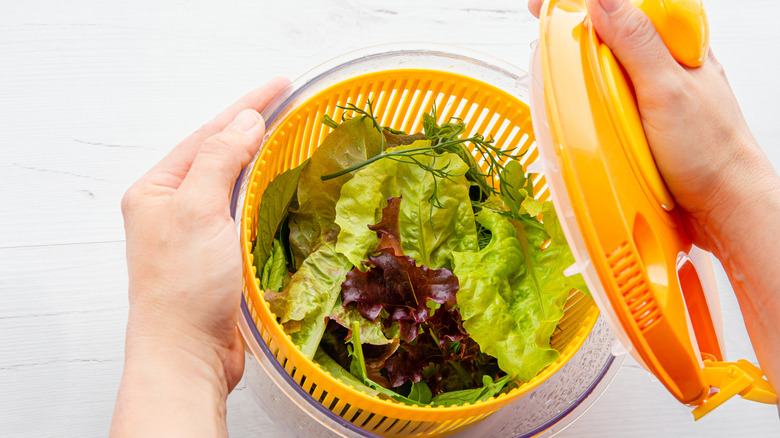The Absolute Best Way To Store Salad Greens To Keep Them Fresh
Big bags of store-bought greens are perfect for making huge salads for a crowd. However, it can be almost impossible to eat through an entire bag or a full head of butterhead lettuce if you're cooking for one. While some salad leaves, like crunchy Romaine hearts, retain their crisp exterior and inviting snap for a lengthy period, others, such as baby spinach, endive, and watercress, wilt quickly, turn soggy, and even get slimy. We asked Megan McCarthy, the Edible Garden Chef at the Atlanta Botanical Garden, about her tried and tested tips on how to store salad greens to keep them fresh.
"Wash and dry greens thoroughly," explains McCarthy, the founder of Healthy Eating 101. "I like to spin my greens dry in a salad spinner, or you can wrap them in paper towels and store them in a loosely sealed plastic bag or container in the refrigerator. Try not to put too much into the storage container to prevent wilting. Most greens will stay fresh for 3–5 days."
Removing the moisture from the surface of salad greens reduces the risk of spoilage and deterioration. While you can dry your washed leaves with paper towels, using a salad spinner is better because it eliminates excess water without damaging the tender leaves (bruised, yellowing, and torn greens will decay faster than those in tiptop condition).
Pack salad greens loosely to allow for air flow
Salad greens will remain fresher for longer if there's a good airflow around each leaf. Packing them loosely, instead of squashing them down into a small container, will therefore help them to retain their sprightly texture and verdant color. Placing a paper towel in the box as McCarthy, who is also the Have A Plant Ambassador for The Foundation for Fresh Produce, advises will also wick away any remaining moisture naturally emitted from the leaves as they sit in the fridge and capture condensation. If this released moisture isn't captured, it will likely settle on the surface of the greens, making them wet, and thereby catalyzing rot (you've likely experienced this if you've ever forgotten about a bag of spinach in the fridge and opened it to find a swampy mess). As always, store your salad greens in the crisper drawer, which is designed to create the most ambient conditions for leaves and delicate produce to stay fresh.
An awesome alternative to salad greens, which doesn't require any finicky prep, is a head of white or red cabbage. You can easily shred cabbage into fine lengths using a mandoline slicer and drizzle over your favorite salad dressing instead of using arugula, butterhead lettuce, and cress.

